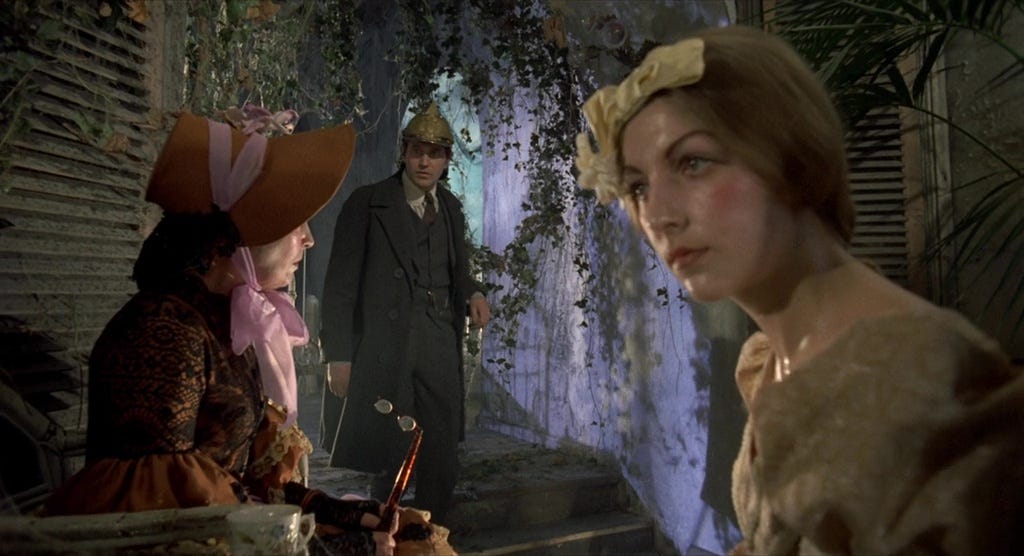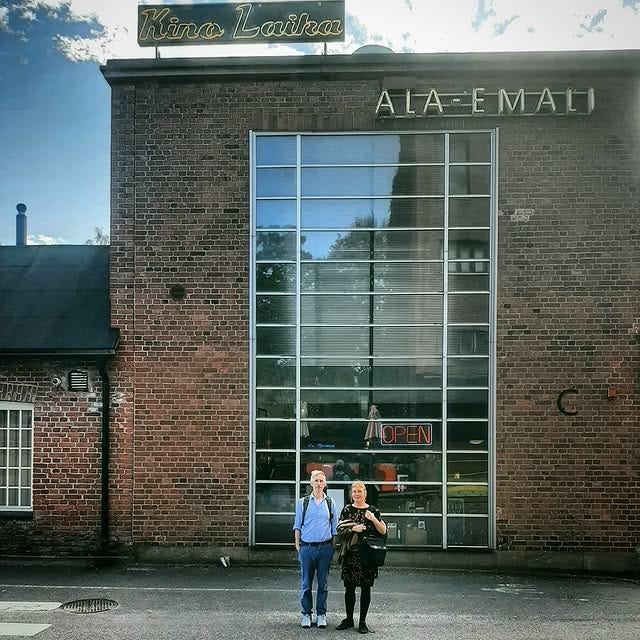◡◶▿ TIME01 | Snowglobe time
🔮 Your characters don't know you're on a cig break nor how long is reasonable to take. Plus: Radu Jude x Adrian Martin; memories overwritten. New Systems of Time Week 1
📹 Unfound Peoples Videotechnic | Cloud-based filmmaking thought. ☁️
Dear perpetual film students,
At the end of last semester, you may remember, I asked if you knew of any books that resonate with the theme and tone of this very mailing list.
Response levels were pitiful. That’s okay! I imagine most of you were already dreaming of the beach. However, I would like to draw attention to one newish book that came up: Adrian “
” Martin’s Filmmakers Thinking.Filmmakers Thinking “begins from a simple premise: that we do not take the ongoing reflections of filmmakers about their medium, their art and their craft, seriously enough.”
And, what’s more, the book “delves into a vast archive of writings (public and private), interviews, talks, and anecdotes to discover what filmmakers think about how to create cinema – and what cinema is, or could be.”
I cannot claim to have read the book yet myself. I plan to! But given that it’s called Filmmakers Thinking and that’s what you came here to be, it seems appropriate to tell you about it. Its foreword was written by Radu Jude, for goodness sake!
You can buy it here. Great!
Okay. Now we’ll get on with the new term. Which is all about new systems of time, and how you design them to operate in the worlds of your characters.
This week, we’ll look at how:
🌏 Each movie is its own self-contained world with its own physical laws.
🔮 Like a little snowglobe.
⌚ There are many ways the filmmaker can adjust the event-substance of time in her movie.
🦫 Films that luxuriate in this snowglobeness of time are rare but, thankfully, repetitive.
Okay. And so.
Snowglobe time
You can hear me deliver this lesson by scrolling up to the header and clicking Listen and/or the play ▸ button.
A movie is a visual snowglobe. A self-contained and safely isolated landscape.
The characters are trapped in a glass ball. Usually, they do not realise this.1 Do any of us? When he looks to the sky, in character, the hero pictures something (or a nothingness) other than the filmmaker and her audience staring back at him from the heavens - his conception of the beyond is, too, bound by glass.
This glass ball of the filmmaker’s design has its own systems of topography, architecture, and meteorology.
But it also has its own, self-contained physics. A world system that recognises only itself. This includes a snowglobe mechanics of time.
The rate at which the snowflakes fall depends on the materials the filmmaker has used. And the vigour with which she shakes her little pet world.
But, this snow globe stuff is more or less an analogy. The filmmaker may design any kind of time physics for that would-be snowglobe. And not just a time physics that responds to the vigour of her wrist (which is, after all, metaphorical).
She has at her disposal not just fake snowflakes and fluids in a range of viscosities, but also:
The omnipotent edit suite.
Camera tricks and cinematographic variations.
Props and sets designed to her specifications.
Access to the ‘real world’ outside the studio with (limited) scope to make adjustments.
The infinite and nefarious potential of the discovery, invention, juxtaposition, and modulation of sound and sounds.
Variable voltage lights, wind machines, and vacuums.
Trained actors.
Soups and energy drinks.
And, with those tools, the filmmaker can do far more than slow or hasten the fall of her snowflakes. She may (for example) change the nature of diegetic time2 by:
Adjusting the relative speed between characters and/or machines, meteorological phenomena, light, sound, and any other screen or audio matter.
(The filmmaker must not forget to factor in the growth and decay rates of each element.)
Adjusting the direction of time (forwards, backwards, and anywhere in between)
universally or
variably across
forms (e.g., people, the art of music, geology) or
elements (e.g., Jack, lower midrange frequencies, rust).
Creating pockets or regions of variable time physics within the world’s broader time system.
Applying novel patterns or rhythms to time as it affects one or more elements.
Or borrowing formal laws from existing genres (e.g., dub) or techniques (pointillism).
Tethering time to one or more visual, sonic, kinetic, emotional, or imaginary values.
Or any other variable within or beyond the movie.
It is common to tether the perception and representation of time (but not diegetic time itself) to a character’s feelings or other perceptions.
Introducing new side-effects or implications of time’s passage.
“Concretising” time (or the movie’s particular understanding of time) through audio/visual manifestations (this is also known as “tinting time”).
Anthropomorphising time (but be wary not to let it forget its main responsibilities).
Applying hyper-literally (even pataphysically) familiar alternative cultural readings of time, such as spectacular-time, time as river or daft parade, time as deity, or insensible adherence (of the movie’s time laws) to the zodiac wheel or other mandala.
Inducing leaks, spillages, cracks, ruts, growths, or atrophies of time.
As a special event within the movie or as a general characteristic of the movie’s fallible time system.
Rethinking clocks and the characters’ relationship to timepieces and, by implication, the nature and timing of meals.
Reimagining ‘time’ without cultural or metrical reference to our time and its habitual velocities and patterns, but something quite otherwise.
Fooling around with causality.
Reimagining the “moment.”
(This list is not exhaustive, but it is long.)
These variations on conventional time can be subtle. They need not even be noticeable to the audience. And they may certainly be applied to otherwise ‘dry’ genres such as the Serious Drama or arthouse pastoral.
But it is rare for a filmmaker (outside of science fiction and fantasy) to reimagine their snowglobe’s time system so deliberately. It is rarer still for a movie to acknowledge or weaponise the fact that snowglobe time is snowglobe time; that it is discreet and particular to that world (even if it seems that time in the movie is more or less normal) and that this phenomenon is noteworthy.
But there are exceptions. Most notable are ‘stacked’ movies that re-use (or appear to) identical footage to loop or echo a chosen timespan across the movie’s duration, rolling out hours, days, or lifetimes like photocopies. Whatever the tale of this sort of movie, the hero’s true plight is that his routine has been printed to film. He has become the plaything of a filmmaker who is fascinated by routine or iteration. (Perhaps the filmmaker is sick of her day job.)
This ‘Groundhog Day’ trope is more common in science fiction than outside it.3 You could call any film that uses it a “science fiction.” However, in that sense, every film is a science fiction. Because not even the most sensible documentary can claim to channel the science (and time laws) of the world outside the movie without disparities, however earnestly the filmmaker believes they traced and represented reality.
Please share your thoughts, queries, and exercises from this week’s lesson in the comments.
Summer has been written over
Perhaps you remember that two summers ago, a Finnish friend foolishly invited me over to be cinematographer on her new film.
Well, this August, I was rushed back to Helsinki to correct my mistakes. Or rather, to make new mistakes, since we shot on Super 8, which cannot be overwritten once processed. Super 8 mistakes last forever, as I learned forever ago.
Meanwhile, my young daughter was also learning: she discovered the video function of her little point-and-shoot camera. And then she discovered ‘mistakenly deleting all her videos.’ Thus joining the great pantheon of filmmakers whose early works are forever lost.
Given that hers is a digital camera, I eventually realised that I might be able to rescue some of the data. Digital data of this nature is, unlike Super 8, gradually overwritten rather than outright lost. I discovered this too late, when she’d already taken a load more photos and videos, and the remaining pentimento of zeroes and ones proved impossible to reanimate.
Dozens of smashed snowglobes glittering on the runway.
I share this as a bonus lesson to you all.
How was your summer? Do any memories remain?
Let me know in the comments!
Next week, we’ll (probably) talk about ambient and slow movies. They may not last forever, but they seem to!
Class dismissed,
~Graeme Cole.
(Principal)
P.S. Here’s a pertinent song recommendation.
🦋 Bluesky | ⏰ TikTok | 📸 Instagram | 😐 Facebook | 🎞️ Letterboxd | 🌐 unfound.video
The filmmaker retains the option to notify them.
The filmmaker needn’t fit the whole science inside the snowglobe; just enough to give a flavour of diegetic time.
It is not a conceit of science fiction nor quite fantasy that traps Bill Murray in Groundhog Day. No, it is a mediaphysical conspiracy between dramatic form (the redemption arc) and the film fabric itself (mechanically reproduced and looped). This is underlined by the twin backgrounds of the annual groundhog festival (and its place in the calendar) and the TV news crew, forever trapped in the search for catharsis within the endless news cycle. (Or perhaps these backgrounds are just a *coincidence* - which is another conceit of narrative time).







Thanks for the shout-out, Graeme! And hope you will (eventually) enjoy the book itself !! By the way, you asked if there have yet been any AI ’animations’ of Chris Marker’s LA JETÉE. This isn’t quite that, but it’s a fascinating (and amusing) experiment by the artist-filmmaker Adrian Goycoolea (do read his accompanying statement, it helps with the appreciation): https://www.youtube.com/watch?v=zAxba28dr6U